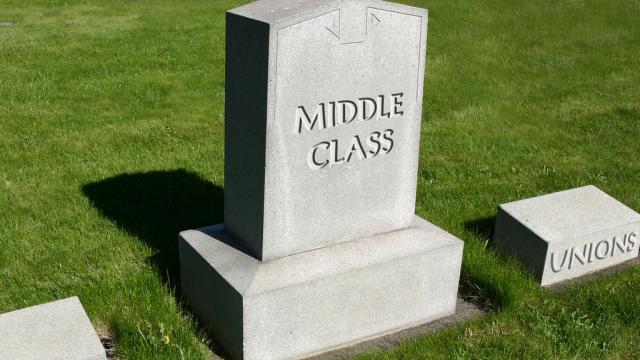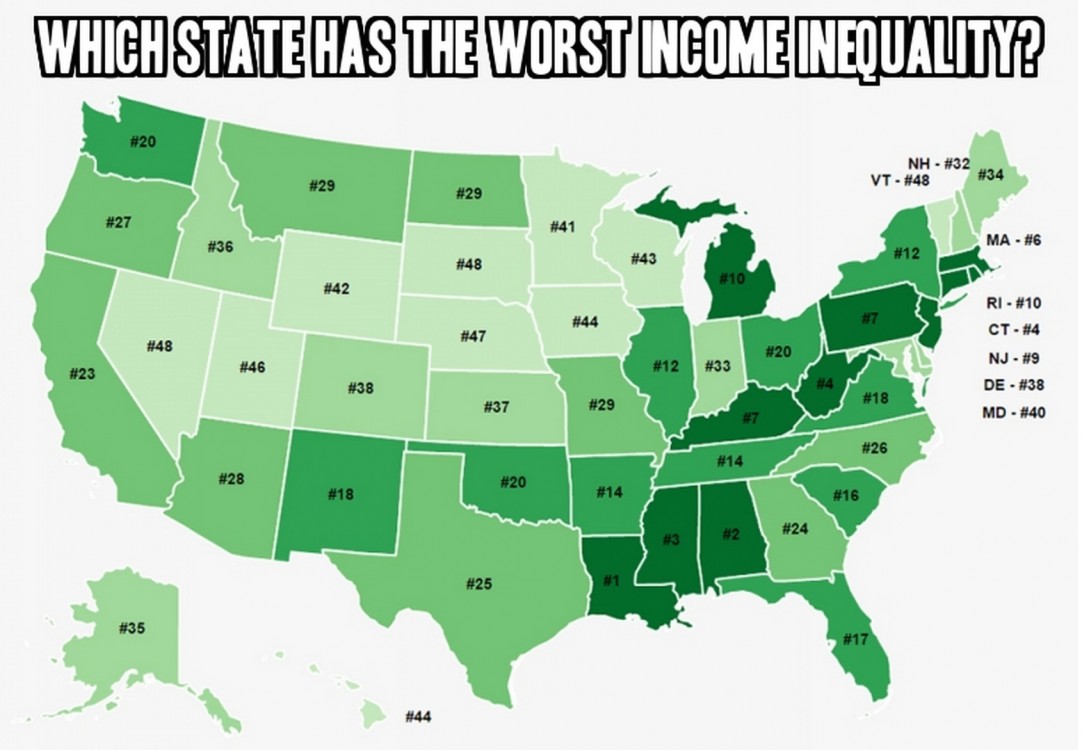
It’s no secret that income inequality – i.e., the difference between the haves and have-nots, or the amount made by men compared to women – is a problem in the U.S. But where does that inequality have the biggest foothold?
In order to find out, the Movoto Real Estate Blog created this map of income equality in each state, looking at everything from gender to household earnings. Using these methods, we found that the following states had the most income inequality, led by Louisiana:
-
Louisiana
-
Alabama
-
Mississippi
-
Connecticut (tie)
-
West Virginia (tie)
-
Massachusetts
-
Pennsylvania (tie)
-
Kentucky (tie)
-
New Jersey
-
Rhode Island (tie)
-
Michigan (tie)
Our Methodology
In order to calculate income inequality and produce this map, we used the 2010 U.S. Census to gather data in four different criteria for each state. Those criteria were:
-
Median income for women compared to median income for men (the greater the difference, the more unequal)
-
Percent of earning households compared to non-earning households (the higher the non-earning, the more unequal)
-
Annual income greater than $100,000 versus annual income less than $25,000 (the smaller the middle class, the more unequal)
-
State income Gini index (the closer to one, the more unequal)
From there, we ranked each place in each category from one to 50, with rankings closer to one being more unequal. Then, we averaged each state’s rankings into one Big Deal Score, and the state with the lowest number for that score was rated the most unequal in the nation.
Take a moment to see why our 10 most unequal states ranked where they did on our overall list:
1. Louisiana
For starters, men here made roughly 1.7 times more than women, the fourth most unequal ranking in that category. The middle class was the ninth smallest, and the Gini index was the third most unequal. Even the non-earning households were ranked a surprising 19th.
2. Alabama
Not the first or last Southern state on our list, Alabama finished close behind our No. 1 spot. The standout scores here were almost 26 percent of households in the state not earning, and the seventh most unequal male income to female income comparison, with males making an average of 1.7 times more.
3. Mississippi
This state placed where it did in our rankings got here because of some pretty telling numbers. The middle class wasn’t exactly strong here, with the high income versus low income ranking at No. 11. When comparing male income to female income, men made on average 1.6 times more than their female counterparts. To top it all off, the Census showed that this state had the fourth most unequal Gini index ranking on our list.
4. Connecticut
Let’s start by acknowledging that Connecticut had a fairly low number of households not earning, at merely 20 percent. However, the rest of the numbers indicated severe inequality in the state. The Gini index was the second most unequal and the middle class was the third smallest. Even women were feeling the inequality, as this state had the 16th most unequal female income versus male income.
4. West Virginia
All of this state’s inequality numbers were in the more unequal half of our rankings, so it’s no surprise that this place was in our top 10. However, what really kept West Virginia in this ranking was the eighth most unequal income for men vs. women, with men making roughly 1.7 times more. Additionally this place had the worst ranking on our entire list for earning vs. non-earning households.
6. Massachusetts
This may be a surprise to some, but the numbers here tell a pretty definitive story. While the male income versus female income was pretty middle of the pack, as was the earning vs. non-earning households ranking, the rest of the scores were dismal. This state had the second smallest middle class, the seventh most unequal Gini.
7. Pennsylvania
Not a single score here was in the most equal half of the rankings. The percent of non-earning households and the inequality of income between men and women both ranked as the 10th worst, while the Gini ranking was the 20th most unequal.
7. Kentucky
Though Kentucky was one of the more equal when it came to men vs. women income, males in this state still made nearly 1.6 times more, and the rest of the rankings here were even worse. This state had the third worst earning vs. non-earning households rank, and the 14th most unequal Gini ranking. Even the middle class here was pretty darn small.
9. New Jersey
While the majority of households here were earning, over 80 percent of them in fact, there were still some definite problems. New Jersey had the 13th most unequal Gini index, and men made an average of 1.6 times more than women. The biggest standout was the smallest middle class on our list. In fact, the majority of people were either very rich or very poor, making the household income split here pretty staggering.
10. Rhode Island
This state showed signs of income inequality across the board, from the high percent of households not earning, to the dwindling middle class, to the 18th most unequal Gini ranking. Men also made over 1.6 times more than women in Rhode Island.
10. Michigan
Tied with Rhode Island for 10th, Michigan had some pretty striking scores. Admittedly, the middle class was a little bigger here and the Gini rank was only 26th. However, this state had both the ninth worse men vs. women income ranking and the 5th worst earning vs. non-earning households rank, keeping it in our top 10.
3 WAYS TO SHOW YOUR SUPPORT
- Log in to post comments












